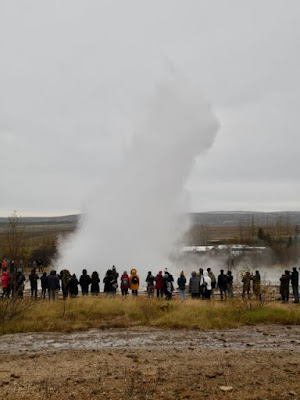Iceland has them all and each one is different. (Yellowstone also has all 4 types.) We saw all four, starting with Geyser Center.
fumarole or steam vent
A fumarole (or fumerole) is a vent in the surface of the Earth or other rocky planet from which hot volcanic gases and vapors are emitted, without any accompanying liquids or solids. The predominant vapor emitted by fumaroles is steam, formed by the circulation of groundwater through heated rock. ~ Wikipedia
people lined up along Strokkur waiting
This geyser, Strokkur, erupts every seven to ten minutes with steam reaching up to 20 meters. I missed a couple of the eruptions, but did get one good photo. In one of the missed photos, a group of younger people were standing along the southern edge of the geyser hole, behind the rope. When it erupted, it spewed steam smelling of sulfur on them. There was LOTS of squealing and running!
a bubbling steam vent
signs warn the temp is 100º C
statue near the hotel at the Geysir Center complex
no explanation, no artist
just interesting and worthy of a photo
Deildartunguhver Hot Spring
There really was this much steam/moisture in the air. I wiped my camera lens often, but this is what it was.
a hole in the volcanic rock wall spewing bubbling water
a small eruption from the volcanic rock wall
Deildartunguhver Hot Spring provides 180 liters of 100ºC water per second. It is one of the most voluminous hot springs in Europe. Since 1979 and 1981, this hot spring provides the water to heat the homes in the communities of Akranes, Borgarnes, and Hvanneyri through conduits some 40 miles away.
(There is also a Krauam Hot Spring Spa at this location. On the Day of our Plan B, some of the people in our group enjoyed time in the spa while I enjoyed exploring The Medieval Village in Reykholt.)
Iceland is a world leader in renewable energy. 100% of Iceland's electricity grid is produced from renewable resources. In terms of total energy supply, 85% of the total primary energy supply in Iceland is derived from domestically produced renewable energy sources.
There are over 200 volcanoes located in Iceland and over 600 hot springs. There are over 20 high-temperature steam fields that are at least 150 °C [300 °F]; many of them reach temperatures of 250ºC. This is what allows Iceland to harness geothermal energy, and these steam fields are used for heating everything from houses to swimming pools. Hydropower is harnessed through glacial rivers and waterfalls, both of which are common in Iceland.
The Icelandic government aspires that the nation will be carbon neutral by 2040. The largest obstacles to this are road transport and the fishing industry. ~ Wikipedia
Mudpots at Sultan
A mudpot, or mud pool, is a type of acidic hot spring, or fumarole, with limited water. It usually takes the form of a pool of bubbling mud, as a result of the acid and microorganisms decomposing surrounding rock into clay and mud.
The mud of a mudpot takes the form of a viscous, often bubbling, slurry. As the boiling mud is often squirted over the brims of the mudpot, a form resembling a mini-volcano of mud starts to build up, sometimes reaching heights of 1 to 1.5 meters. The mud of a mudpot is generally of white to greyish color, but is sometimes stained with reddish or pink spots from iron compounds. When the slurry is particularly colorful, the feature may be referred to as a paint pot.
Mudpots form in high-temperature geothermal areas where water is in short supply. The little water that is available rises to the surface at a spot where the soil is rich in volcanic ash, clay, and other fine particulates. The thickness of the mud usually changes along with seasonal changes in the water table. ~ Wikipedia















No comments:
Post a Comment
Thanks for your comments!